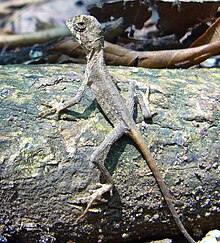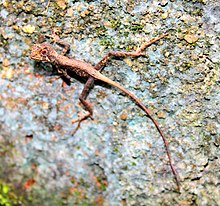Otocryptis wiegmanni
| Otocryptis wiegmanni | |
|---|---|

| |
| Otocryptis wiegmanni at Udawattakele, Kandy, Sri Lanka. | |
| Scientific classification | |
| Domain: | Eukaryota |
| Kingdom: | Animalia |
| Phylum: | Chordata |
| Class: | Reptilia |
| Order: | Squamata |
| Suborder: | Iguania |
| Family: | Agamidae |
| Genus: | Otocryptis |
| Species: | O. weigmanni
|
| Binomial name | |
| Otocryptis weigmanni Wagler, 1830
| |
| Synonyms[2] | |
Otocryptis wiegmanni, commonly called the brown-patched kangaroo lizard, Sri Lankan kangaroo lizard or Wiegmann's agama, is a small, ground-dwelling agamid lizard endemic to Sri Lanka.
Etymology
The specific name, wiegmanni, is in honour of German herpetologist Arend Friedrich August Wiegmann.[3][2]
Habitat
The preferred habitat of O. wiegmanni is the wet zone forests and lower mountain forests (rainfall >2000 mm[4]), up to 1,300 m (4,300 ft), of Sri Lanka. It is commonly seen in the leaf litter of shady rain forests.[5][6]

Defensive behaviour
When perceiving danger, O. wiegmanni spurts away quickly on its large hind legs and might eventually climb up a sapling or tree.[5][6]
Diet
O. wiegmanni feeds on small insects, grubs, and tender shoots.[5][6]
Taxonomy
O. wiegmanni is closely related to the Indian kangaroo lizard (
Description
O. wiegmanni may grow to an adult body size of about 7 cm (2.8 in) snout-to-vent length (SVL), plus a tail 15 cm (5.9 in) long. Its colour ranges from dark reddish brown to dull brown. Males are darker than females.
Reproduction
Male O. wiegmanni are territorial and can defend their territory against intruders through displays and fights.[4] Females lay between three and five eggs in a nest in the ground between July and January, with a peak between October and January.[5][6] The eggs are ellipsoidal, measuring 7 mm–7.5 mm × 10 mm–17 mm (0.28 in–0.30 in × 0.39 in–0.67 in). Hatchlings emerge after 57–70 days.
References
- ^ Wagler J (1830). Natürliches System der AMPHIBIEN, mit vorangehender Classification der SÄUGTHIERE und VÖGEL. Ein Beitrag zur vergleichenden Zoologie ". Munich, Stuttgart and Tübingen: J.G. Cotta. vi + 354 pp. + one plate. (Otocryptis wiegmanni, new species, p. 150). (in German and Latin).
- ^ a b Otocryptis wiegmanni at the Reptarium.cz Reptile Database. Accessed 27 June 2017.
- ISBN 978-1-4214-0135-5. (Otocryptis wiegmanni, p. 285).
- ^ a b c Karunarathna, D. M.S. Suranjan; Amarasinghe, A. A. Thasun (2007). "Notes on the territorial behaviour of Otocryptis wiegmanni Wagler, 1830 (Reptilia: Agamidae: Draconinae)". Herpetotropicos. 4 (2): 79–83.
- ^ Deraniyagala PEP(1953). A Colored Atlas of some Vertebrates from Ceylon, Volume 2. p. 58.
- ^ a b c d e Das, Indraneil; de Silva, Anslem (2005). Photographic Guide to Snakes and other Reptiles of Sri Lanka. London. p. 88.
External links
Further reading
- Boulenger GA (1885). Catalogue of the Lizards in the British Museum (Natural History). Second Edition. Volume I ... Agamidæ ... London: Trustees of the British Museum (Natural History). (Taylor and Francis, printers). xii + 436 pp. + Plates I-XXXII. (Otocryptis bivittata, pp. 271–272).
- Smith MA (1935). The Fauna of British India, Including Ceylon and Burma. Reptilia and Amphibia. Vol. II.—Sauria. London: Secretary of State for India in Council. (Taylor and Francis, printers). xiii + 440 pp. + Plate I + 2 maps. (Otocryptis wiegmanni, pp. 146–147).
